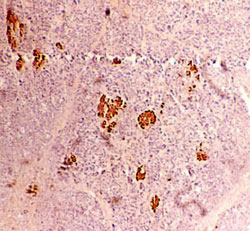Treating diabetes
Before insulin was discovered, type 1 diabetics would suffer terribly and die young. They would lose weight rapidly and were often described as living skeletons. Insulin treatment has saved many hundreds of thousands of lives.
Symptoms of type 2 diabetes are much less obvious but blood glucose levels are still not regulated properly. The graph shows the fluctuations in glucose levels throughout the day in a healthy person and the effects of type 2 diabetes.
The graph shows how the blood glucose levels vary during the day. After a meal, the level rises as glucose is absorbed from digested food.
Non-diabetics are able to store this excess glucose and their blood glucose level is returned back to normal. Type 1 and type 2 diabetics cannot store this glucose and their blood glucose levels remain above normal between meals.
As diabetics are unable to store glucose in the liver , if they miss a meal, or are very active, the glucose in the blood becomes depleted. There is no store in the liver to release glucose and so levels can fall dangerously low. If left untreated, this may trigger confusion, loss of consciousness and even a coma. Take a look at the graph above to see what could happen if a diabetic person misses a meal.
Unregulated blood glucose
If a diabetic does not regulate their blood glucose, it can fluctuate between excessively high levels ( hyperglycaemia ) and low levels ( hypoglycaemia ). Medicines can help prevent this but if the person does not regulate their glucose levels properly, over several years, both can cause problems.
|
Hyperglycaemia
|
Hypoglycaemia
|
|---|---|
|
Blood glucose above normal
|
Blood glucose below normal
|
|
Damage to blood vessels and kidneys
|
Weight loss
|
|
Prolonged raised levels can lead to limb amputations and
blindness
|
Tiredness
|
|
In severe cases, loss of consciousness. Easily treated by medical
personnel if noticed quickly. Dangerous if left untreated.
|
|
Treating Type 1 diabetes
Insulin injections can successfully treat type 1 diabetes. The hormone allows the liver, and other cells in the body, to take in and store glucose normally. Researchers have developed different types of insulin medications. Some act quickly but for only a short period of time. Others take effect more slowly but last longer. Diabetics may take combinations of these insulins to regulate their blood glucose level over a 24-hour period. A balanced diet and regular meals are important in managing type 1 diabetes.
Treating Type 2 diabetes
Type 2 diabetes generally happens in the over 40's and can be treated using combinations of medicines, insulin, diet control and exercise.

Medication can be taken to increase insulin secretion in the pancreas.
Courtesy of: Anne Clark / Wellcome Images
Healthy diet
- Regular meals with foods that contain starch (bread, pasta, potatoes and rice).
- Reduce sugary foods like carbonated drinks, cakes and sweets.
- If obese, losing weight will help to control the disorder.
Medicines
- Stimulate the production of insulin from the pancreas.
- Make body cells more sensitive to the insulin that is available.
- Slow the absorption of glucose from the digestive system.
Regular exercise
- Helps the body to regulate its blood glucose levels.
- Reduces weight.
- Improves blood pressure and lessens the chances of circulation problems.
New Treatments
Injecting insulin on a regular basis can cause problems such as skin inflammation at places that are regularly used. Researchers are constantly working to develop better ways for patients to take insulin with the aim of helping sufferers maintain closer control of their blood glucose levels.
Insulin is a protein and would be digested and inactivated if taken orally in tablets or capsules. Skin patches are being developed that allow the insulin to be directly absorbed into the body through the skin. Implants under the skin may also be a treatment of the future.
Small pumps are now available which inject insulin under the skin in a controlled way throughout the day. Miniaturised 'nanopumps' may soon replace the large pump shown here.
In the future, it may be possible to treat diabetes with gene therapy. This replaces faulty genes with working ones.

Pumps deliver controlled amounts throughout the day.

Using nanopumps may allow insulin to be delivered from pumps the size of skin patches.
Courtesy of: Insulin Nanopump™ from Debiotech SA, Switzerland
Question 3
What would you recommend?
Jim is a 47 year old man. He is 1.75m tall and weighs 120kg. Doctors would describe him as being obese. He does little exercise, drinks alcohol two or three times a week and has a diet that includes lots of take-away meals because he is busy with his job.
How would you rate Jim's risk of developing type 2 diabetes? What changes would you recommend him to make in his lifestyle?











